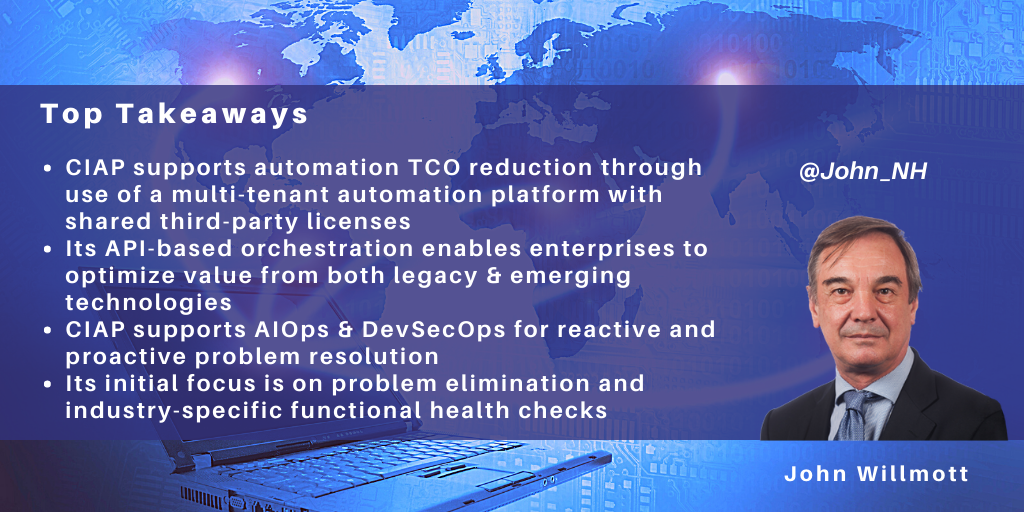Search posts by keywords:
Filter posts by author:
Related NEAT Reports
Other blog posts
posted on Nov 10, 2020 by John Willmott

Capgemini has just launched version 2 of the Capgemini Intelligent Automation Platform (CIAP) to assist organizations in offering an enterprise-wide and AI-enabled approach to their automation initiatives across IT and business operations. In particular, CIAP offers:
- Reduced TCO and increased resilience through use of shared third-party components
- Support for AIOps and DevSecOps
- A strong focus on problem elimination and functional health checks.
Reduced TCO & increased ability to scale through use of a common automation platform
A common problem with automation initiatives is their distributed nature across the enterprise, with multiple purchasing points and a diverse set of tools and governance, reducing overall RoI and the enterprise's ability to scale automation at speed.
Capgemini aims to address these issues through CIAP, a multi-tenanted cloud-based automation solution that can be used to deliver "automation on tap." It consists of an orchestration and governance platform and the UiPath intelligent automation platform. Each enterprise has a multi-tenanted orchestrator providing a framework for invoking APIs and client scripts together with dedicated bot libraries and a segregated instance of UiPath Studio. A central source of dashboards and analytics is built into the front-end command tower.
While UiPath is provided as an integral part of CIAP, CIAP also provides APIs to integrate other Intelligent Automation platforms with the CIAP orchestration platform, enabling enterprises to continue to optimize the value of their existing use cases.
The central orchestration feature within CIAP removes the need for a series of point solutions, allowing automations to be more end-to-end in scope and removing the need for integration by the client organization. For example, within CIAP, event monitoring can trigger ticket creation, which in turn can automatically trigger a remediation solution.
Another benefit of this shared component approach is reducing TCO by improved sharing of licenses. The client no longer has to duplicate tool purchasing and dedicate components to individual automations; the platform and its toolset can be shared across each of infrastructure, applications, and business services departments within the enterprise.
CIAP is offered on a fixed-price subscription-based model based on "typical" usage levels, with additional charges only applicable where client volumes necessitate additional third-party execution licenses or storage beyond those already incorporated in the package.
Support for AIOps & DevSecOps
CIAP began life focused on application services, and the platform provides support for AIOps and DevSecOps, not just business services.
In particular, CIAP incorporates AIOps using the client's application infrastructure logs for reactive and predictive resolutions. In terms of reactive resolutions, the AIOps can identify the dependent infrastructure components and applications, identify the root cause, and apply any automation available.
CIAP also ingests logs and alerts and uses algorithms to correlate them, so that the resolver group only needs to address a smaller number of independent scenarios rather than each alert individually. The platform can also incorporate the enterprise's known error databases so that if an automated resolution does not exist, the platform can still recommend the most appropriate knowledge objects for use in resolution.
Future enhancements include increased emphasis on proactive capacity planning, including proactive simulation of the impact of change in an estate and enhancing the platform's ability to predict a greater range of possible incidents in advance. Capgemini is also enhancing the range of development enablers within the platform to establish CIAP as a DevSecOps platform, supporting the life cycle from design capture through unit and regression testing, all the way to release within the platform, initially starting with the Java and .NET stacks.
A strong focus on problem elimination & functional health checks
Capgemini perceives that repetitive task automation is now well understood by organizations, and the emphasis is increasingly on using AI-based solutions to analyze data patterns and then trigger appropriate actions.
Accordingly, to extend the scope of automation beyond RPA, CIAP provides built-in problem management capability, with the platform using machine learning to analyze historical tickets to identify the causes and recurring problems and, in many cases, initiate remediation automatically. CIAP then aims to reduce the level of manual remediation automation on an ongoing basis by recommending emerging automation opportunities.
In addition to bots addressing incident and problem management, the platform also has a major emphasis within its bot store on sector-specific bots providing functional health checks for sectors including energy & utilities, manufacturing, financial services, telecoms, life sciences, and retail & CPG. One example in retail is where prices are copied from a central system to store PoS systems daily. However, unreported errors during this process, such as network downtime, can result in some items remaining incorrectly priced in a store PoS system. In response to this issue, Capgemini has developed a bot that compares the pricing between upstream and downstream systems at the end of each batch pricing update, alerting business users, and triggering remediation where discrepancies are identified. Finally, the bot checks that remediation was successful and updates the incident management tool to close the ticket.
Similarly, Capgemini has developed a validation script for the utilities sector, which identifies possible discrepancies in meter readings leading to revenue leakage and customer dissatisfaction. For the manufacturing sector, Capgemini has developed a bot that identifies orders that have gone on credit hold, and bots to assist manufacturers in shop floor capacity planning by analyzing equipment maintenance logs and manufacturing cycle times.
CIAP has ~200 bots currently built into the platform library.
A final advantage of using platforms such as CIAP beyond their libraries and cost advantages is that they provide operational resilience by providing orchestrated mechanisms for plugging in the latest technologies in a controlled and cost-effective manner while unplugging or phasing out previous generations of technology, all of which further enhances time to value. This is increasingly important to enterprises as their automation estates grow to take on widespread and strategic operational roles.
